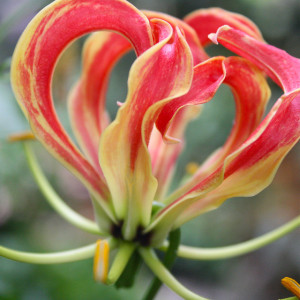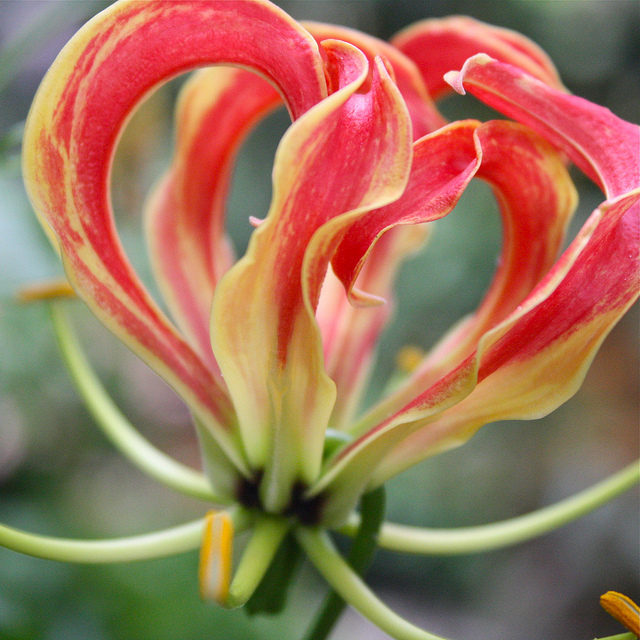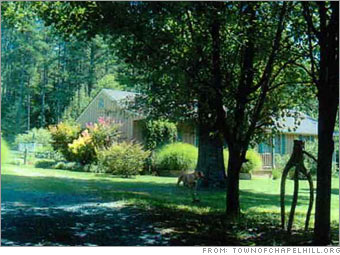I love going to botanical gardens to see the various ways professional landscape designers have arranged plants and structures into pleasing compositions. And I like attending garden tours to see how homeowners and designers have overcome those problems that seem common to nearly every home—how to hide the HVAC system, how to make the front entrance focal and inviting, how to accommodate outdoor activities while still having the home look like a home and not a playground or a city park. Garden tours are great places to steal ideas. Trial gardens, on the other hand, never seem to inspire me. They are a great place to see the latest efforts of plant breeders and hunters. They have marvelous plants at the trial gardens at Park Seed and the University of Georgia and the Raulston Arboretum at NC State, but I never want to bring them home. It may be because trial gardens are set-up like vegetable gardens—all the plants are evenly spaced and in rows. Who can take inspiration from that? It may be how I want my closet arranged, but not my landscape.
Each spring and summer the nurseries and garden centers are full of those latest and greatest plants that were the best performers in the trial gardens around the country during the past few years. Before you let your plant lust get the better of your judgement (and wallet), I urge you to proceed with foresight.
Being of an ecological bent gives me another reason to dislike trial gardens and those “latest and greatest” plants. Gardeners and landscapers have been responsible for some of the worst invasive species that now inhabit our wild lands. Most of the “new” plants always seem to hail from foreign places. Because we don’t require any sort of hazard screening before they are released, who’s to say there’s no potential problems among them? Any one of them could be the next congongrass, privet, Japanese honeysuckle, nandina, English ivy or “ugly Agnes.”
Just recently, I read that the Earth has lost half of its land-dwelling vertebrates—birds, mammals, reptiles, amphibians, and freshwater fishes—since 1970. Not species, but numbers of individuals. Except for pets (dogs, cats, goldfish, etc.) and pests (think rats, mice and pigeons), it seems everybody else suffers because of us humans. Doug Tallamy and other university researchers have documented how songbirds and other wildlife are so very dependent on the insects and other critters that live on native plants. Our local birds cannot make a living hunting among the exotic plants that are typical in our landscapes. Even the varieties and cultivars derived from our native plants are usually less valuable than their wild counterparts—because their flower geometry has changed, or they’re sterile, or some other change has made them less likely to produce or support bird food.
The latest plant releases are also the most expensive. If you garden on a budget, you don’t want to pay fifteen or twenty dollars (or more!) for a small plant in a two-inch square pot. The first plant listed on the Plant Delights website as “new for 2015” is an agave that comes in a 3½” pot for $28 (plus shipping). This is for a tropical plant that won’t survive our winters. I may be cheap, but I’d rather get more bang for my buck. Even at Plant Delights, beautiful crested irises, cardinal flowers and many more plants are available at half that price or less. And you can get much more for your money buying locally.
I find pleasure in saving seeds and taking cuttings to root. If I like a plant and it thrives in my garden, I want to be able to plant it other places and share it with friends. The latest plant introductions are often engineered plants—ones propagated by tissue culture, that spend the first few weeks of their life in a test tube or petri dish. Often home gardeners cannot propagate these plants themselves, either because they lack the laboratory technology necessary or because they are forbidden to do so legally.
 I’ll be the first to admit that I find many of the newest plants and many exotics beautiful. I’ll go out of my way to admire a Lycoris aurea or a gloriosa lily. But because I’m cheap, and I want to try to be an environmentally responsible gardener, I want plants like this to be the exceptions in my landscape, to be like jewels on a rich tapestry of mostly native plants.
I’ll be the first to admit that I find many of the newest plants and many exotics beautiful. I’ll go out of my way to admire a Lycoris aurea or a gloriosa lily. But because I’m cheap, and I want to try to be an environmentally responsible gardener, I want plants like this to be the exceptions in my landscape, to be like jewels on a rich tapestry of mostly native plants.





